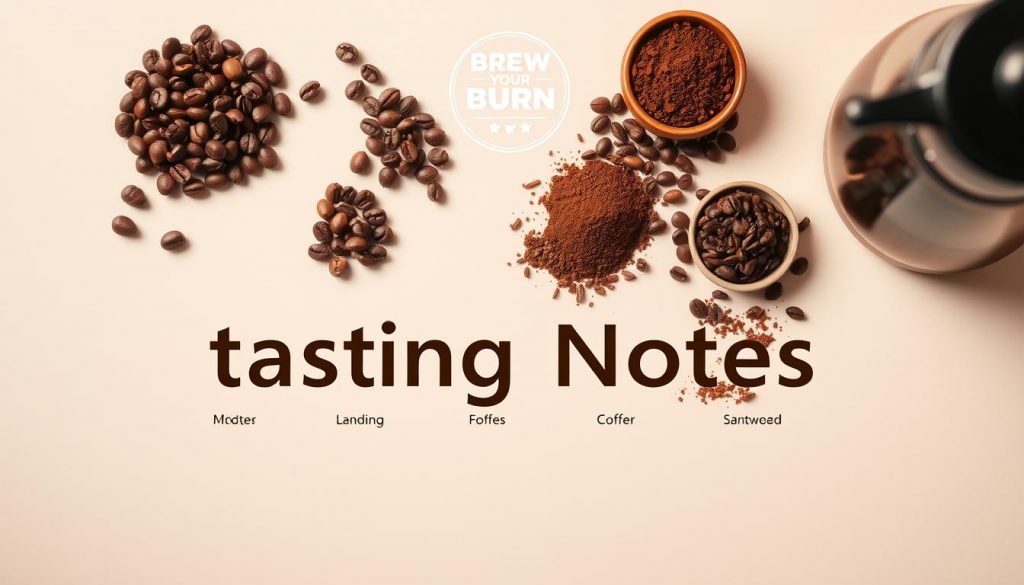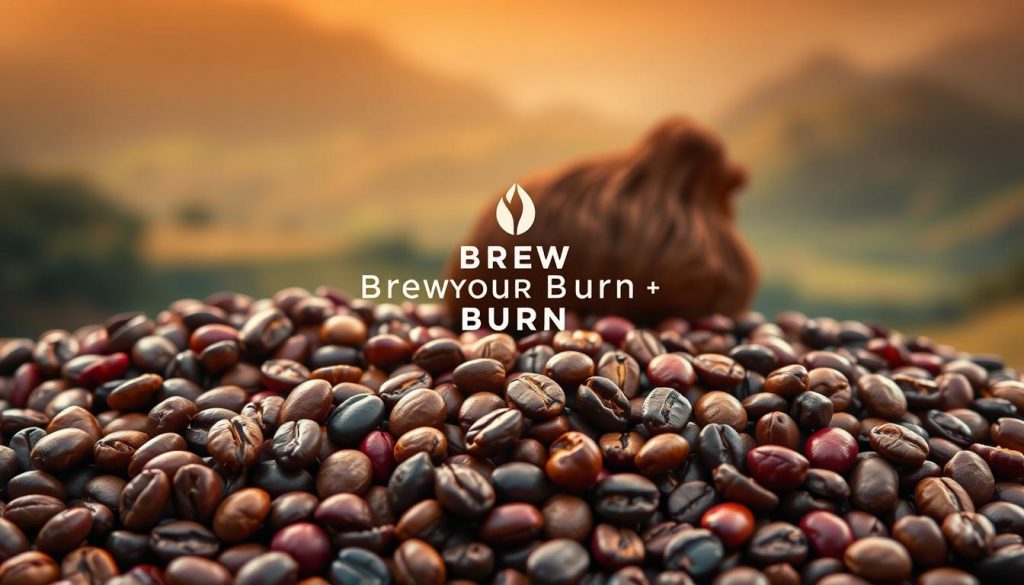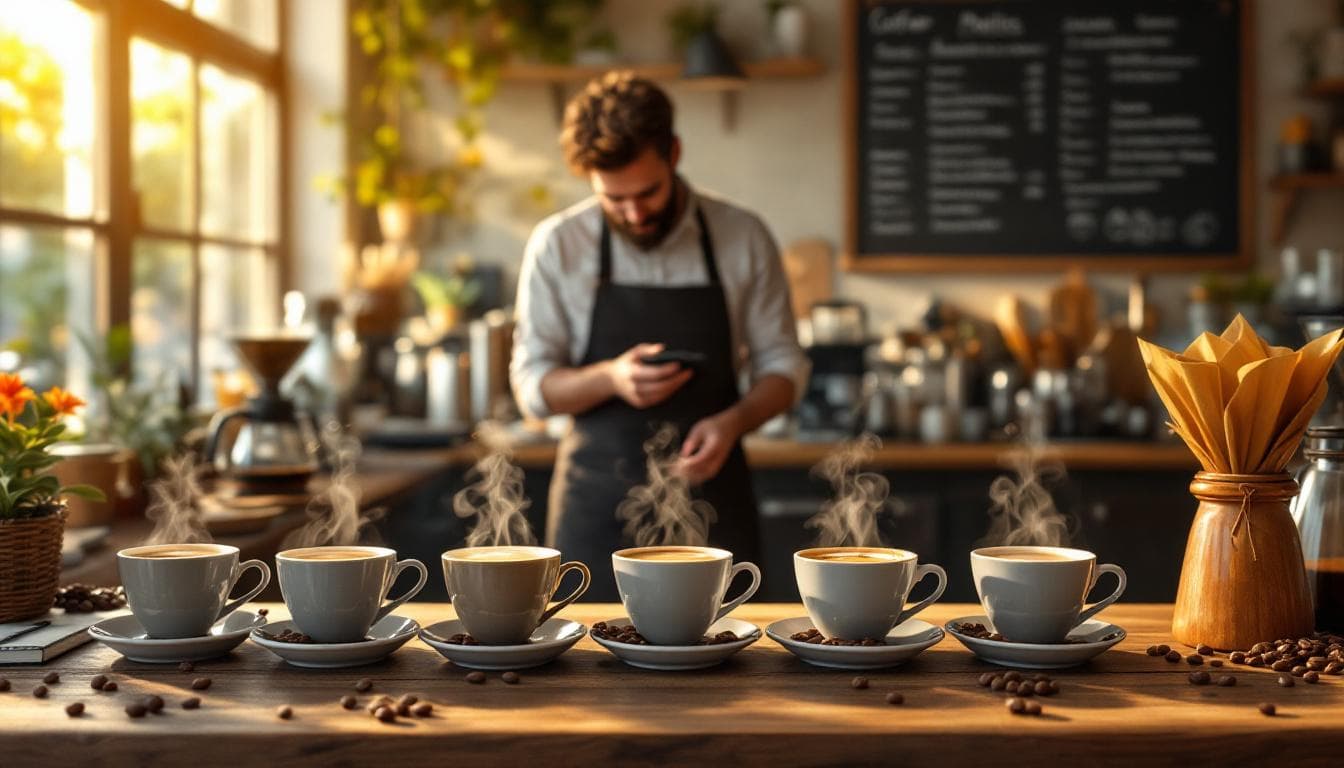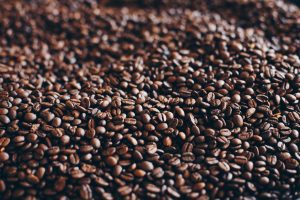Many of us have a special bond with coffee’s taste. What one person finds bright and fruity, another might see as more subtle.
It’s all about how we perceive flavors.
Coffee is packed with hundreds to thousands of compounds. Things like genetics, soil, water, and how it’s harvested all play a role.
Even the same plant can taste different.
Experts use tools like the Specialty Coffee Association’s flavor wheel to guide them.
They follow a set of steps to describe what they taste. This helps everyone involved in coffee know what to expect.
For those who brew coffee at home, keeping a brew log is helpful. It shows what you like, like sweetness or a certain acidity.
This way, you can describe coffee more accurately.

Key Takeaways
- Coffee flavor profiles explained means both science and personal perception.
- Understanding coffee flavors requires tasting, tracking, and comparing.
- The Java flavor spectrum is shaped by genetics, terroir, and processing.
- Professional tools like the flavor wheel bring consistency to tasting.
- A brew log helps home drinkers identify repeatable preferences.
What coffee flavor profiles explained means for home brewers and professionals
When you read about coffee flavor profiles, you get a guide to what people taste. This guide turns quick thoughts into clear words.
It helps both casual coffee lovers and experts understand and enjoy coffee better.
Defining the phrase and why it matters
The term breaks down coffee’s taste into parts like aroma and sweetness. Tools like the SCAA flavor wheel help everyone use the same language.
This way, we can talk about coffee’s taste in a way that’s easy to understand.
How flavor profiles inform brewing, roasting, and purchasing decisions
For home brewers, knowing flavor profiles helps pick the right beans and adjust brewing.
If you like caramel and chocolate, choose a medium roast. Adjust brewing to bring out sweetness.
For bright berry notes, pick beans and roast levels that highlight acidity.
Professionals use flavor profiles to set roast levels, advise farmers, and price coffee.
Roasters at places like Blue Bottle and Stumptown use clear language to make consistent coffee.
This makes it easier to know what to expect from different beans and roasts.
Differences in perception between casual drinkers and professional cuppers
Casual drinkers often just say if they like a coffee or not. But professionals use a detailed method to score coffee.
They look at things like fragrance and aftertaste. This helps them talk about coffee in a way that’s useful for trade and quality control.
Your taste might not match a professional’s notes, and that’s okay. By practicing and using tools like flavor wheels, you can improve.
Over time, you’ll get better at understanding coffee tastes and making good choices when you buy or brew coffee.
| Audience | Primary Use | Typical Notes Highlighted | Actionable Outcome |
|---|---|---|---|
| Home brewer | Choosing beans and adjusting brew | Caramel, chocolate, berry, citrus | Select roast level, tweak grind and time |
| Roaster | Shaping roast profile for consistency | Body, sweetness, roast development, acidity | Adjust roast curve and batch decisions |
| Green buyer | Evaluating lots and setting prices | Origin character, defects, fruit notes | Source contracts and recommend processing |
| Professional cupper | Quality control and description | Fragrance, flavor, aftertaste, balance | Provide standardized coffee tasting notes |
| Casual drinker | Daily enjoyment and purchase | Overall sweetness or bitterness, favorite flavors | Choose beans to match personal taste |
How coffee chemistry creates complex tastes and aromas
The scent and taste you enjoy start with tiny molecules. Roasted Arabica holds thousands of extractable compounds.
These compounds form during growth, processing, and roasting.
Genetics and terroir set the pool of chemical precursors. These precursors react under heat.
Coffee chemistry explains how sugars, amino acids, and acids become flavor. Sugars caramelize to yield caramel and toffee notes.
Maillard reactions between amino acids and sugars create toasted, nutty, and bread-like aromas.
Volatiles and thiols deliver fruity and floral highlights. Acids such as citric and malic give bright, citrus or apple-like acidity.
Caffeine and certain phenolics add bitter balance.
Understanding these links helps you predict changes in a cup.
Shift the roast degree and you change the balance of sugars and phenolics.
Adjust processing and you alter the precursors available for those roast reactions.
Thousands of chemical compounds in roasted Arabica and their role in flavor
Roasted Arabica contains a vast mixture of volatiles, acids, and nonvolatile solubles.
Each class of compound contributes texture, acidity, sweetness, or aroma. Many are present in tiny amounts yet shape what you perceive.
Which compounds produce fruity, floral, sweet, bitter, and roasted notes
Esters and certain thiols often create fruity and floral notes. Caramel and toffee arise from sugar degradation and polymerization.
Maillard products bring roasted, nutty, and cereal-like character.
Organic acids add brightness and lift. Alkaloids and phenolic compounds contribute bitterness and astringency.
How processing and fermentation change chemical composition
Processing alters the bean before it meets heat. Natural (dry) processing tends to preserve and amplify fruity esters.
This gives a sweeter, fruit-forward cup.
Washed processing highlights clearer acidity and floral notes by removing mucilage early.
Controlled fermentation can form new acids and volatiles. This shifts or intensifies fruit characters.
Producers and roasters intentionally choose processing and fermentation to shape the Java flavor spectrum you taste.
When you apply a coffee aroma guide and coffee flavor profiles to buying or roasting decisions, you gain predictable outcomes in the cup.

Using the coffee flavor wheel to identify tasting notes
The coffee flavor wheel is a great tool for exploring coffee. It helps turn vague feelings into clear language.
Use it to understand the aroma and taste of coffee, whether you’re cupping or just brewing at home.
Origin and evolution of the wheel
The first Coffee Taster’s Flavor Wheel was introduced by the Specialty Coffee Association of America over twenty years ago.
Later, World Coffee Research added 110 attributes to a sensory lexicon. The SCAA then updated the wheel to match this new list.
This effort created a common language for coffee tasting notes in the industry and for everyday coffee lovers.
How to read the wheel: from broad categories to specific notes
Start in the middle with broad categories like fruity, floral, roasted, sweet, and bitter.
Move outwards to find more detailed descriptions like berry, citrus, or toasted nut.
The inner ring helps name the general family, while the outer ring is for more specific impressions.
Practical exercises to train your palate with the wheel
Start with small steps. First, smell the dry grounds, then add hot water.
Taste the coffee as it cools to notice changes. Try comparing different coffees side by side to see their differences.
Use real foods to calibrate your taste. Try a ripe blueberry, a spoon of honey, and a toasted almond to match the wheel’s descriptions.
Keep a tasting log to record your findings, listing the wheel categories and specific descriptors for each cup.
| Exercise | What to do | Goal |
|---|---|---|
| Dry grounds sniff | Smell freshly ground beans before adding water | Identify base aroma category (floral, fruity, roasted) |
| Post-pour aroma | Smell immediately after pouring hot water over grounds | Spot volatile notes like citrus or jasmine |
| Hot sip and cool cup | Taste while hot, then again as it cools | Track evolving coffee tasting notes and aftertaste |
| Side-by-side cupping | Compare two brews using the wheel as reference | Highlight differences when exploring coffee profiles |
| Food pairing calibration | Match coffee notes with a small sample of food (berry, honey, nut) | Anchor descriptors to familiar flavors for consistent notes |
Common coffee taste descriptions and what they mean

When you read coffee tasting notes, you’ll see the same words over and over.
These words help you connect what you taste to how the coffee was made. They help you pick the right coffee for your taste.
Sweet notes: brown sugar, caramel, honey, molasses
Sweetness in coffee comes from natural sugars and how it’s roasted. Brown sugar and caramel come from roasting. Honey and molasses make the coffee feel thick and syrupy.
Sweetness balances out the acidity, making the coffee smooth and dessert-like.
Fruity notes: berries, cherries, tropical fruit, dried fruit
Fruitiness in coffee can range from bright citrus to deep berry. Strawberries and blueberries show lively acidity.
Tropical fruits like passionfruit come from Ethiopian or Kenyan beans. Dried fruit hints at concentrated sugars from processing.
These notes help you understand the coffee’s origin and processing.
Floral and tea-like notes: jasmine, rose, black tea
Floral aromas are delicate and aromatic. Jasmine and rose give a perfume-like quality.
Tea-like notes, like black tea, add astringency. These qualities are prized in specialty coffee and show high aromatic complexity.
Roasted and savory notes: toasted cereal, roasted nuts, smoky
Roasted and savory flavors come from the roast level and bean type. Toasted cereal or malt gives a warm, biscuity taste.
Roasted nuts add a pleasant nuttiness. Smoky notes come from darker roasts.
These notes help you decide if they enhance or mask the coffee’s origin.
Bitter and balancing sensations from caffeine and roast
Bitterness in coffee comes from caffeine and compounds from roasting. A good balance of bitterness, sweetness, and acidity is key.
Too much bitterness means the coffee is over-roasted or not brewed right. Paying attention to these helps you understand coffee flavors better.
Keep a flavor log to track your preferences. Over time, you’ll get better at using coffee taste descriptions to find your favorite flavors.
Deciphering coffee tastes during cupping and everyday tasting
Tasting coffee is a step-by-step process. It helps you understand what a cup is saying.
By following simple steps, you can separate the fragrance from the flavor. This makes it easier to compare and share coffee flavors.
Professional cupping protocol
- Evaluate dry fragrance of the ground coffee to catch initial aromatics.
- Smell the wet grounds once water is added to assess the full aroma.
- Slurp the brew to spread liquid across the palate and record flavor and acidity.
- Note aftertaste and body as the cup cools to identify texture and lingering notes.
- Check uniformity and defects to ensure a reliable profile for buyers or roasters.
Temperature is key. Hot cups show off volatile aromatics and bright acids. As it cools, sweetness and body come out.
Later, you might notice chocolate or dried fruit notes. Tasting at different temperatures shows the coffee’s full range.
Recording your observations helps you learn. Use a consistent vocabulary from the flavor wheel.
Log details like country, region, roast level, brew method, and precise descriptors.
Below is a compact tasting log you can adapt. Use it to map patterns in your preferences and reproduce favorite results.
| Date | Origin / Roast | Brew Method | Temp Stages | Tasting Notes | Acidity / Body |
|---|---|---|---|---|---|
| 2025-08-01 | Colombia, Medium | Pour-over, 16:1 | Hot, Warm, Cool | Brown sugar, red apple, mild cocoa | Bright / Medium |
| 2025-08-08 | Ethiopia, Light | Immersion, French press | Hot, Warm, Cool | Jasmine, lemon, ripe blueberry | Vibrant / Light-Medium |
| 2025-08-15 | Guatemala, City | Espresso, 18g/36g | Hot, Warm | Caramel, toasted almond, dark cherry | Balanced / Full |
Use a clear coffee aroma guide when you smell and taste. Repeat entries after small changes in grind, dose, or time.
This sharpens your palate and improves your ability to describe and buy coffee.
How origin, variety, and terroir shape the Java flavor spectrum

Understanding coffee flavors starts with the plant. Genetics define the base flavor potential of a bean.
Cultivars like Bourbon, Caturra, and Typica carry different sugar, acid, and oil balances that influence sweetness and aroma.
Individual plants of the same varietal still show variation, so producers often blend nearby lots to create consistent origin coffee flavors.
Terroir refers to the physical environment where coffee grows. Soil minerals, altitude, and rainfall shape bean development.
High-altitude lots tend to yield denser beans with brighter acidity and pronounced fruit or floral notes. Lower elevations often develop rounder body and chocolatey or nutty tones.
These patterns help explain regional signatures you recognize when tasting.
Water availability and soil composition tweak acidity and fruitiness. Volcanic soils in Guatemala and Colombia often lend clarity and vivid fruit notes.
In contrast, heavier clay soils in parts of Brazil favor cocoa and caramel traits. Small changes in irrigation, shade cover, or microclimate can shift the cup from citrusy to stone-fruit characteristics.
Roasters and buyers use knowledge of origin tendencies to guide their work. A roaster targeting bright, tea-like cups will roast Ethiopian Yirgacheffe differently than a roaster highlighting chocolate notes from Minas Gerais.
When you shop, origin descriptors act as a roadmap for the coffee flavor profiles explained in listings and tasting notes.
Regional flavor tendencies form a practical shorthand. East African coffees often show floral and berry notes. Central American lots commonly present red fruit and crisp acidity.
South American beans frequently trend toward cocoa, peanut, and honeyed sweetness.
Knowing these tendencies improves your understanding coffee flavors and helps you explore the java flavor spectrum with purpose.
| Factor | Typical Influence on Cup | Example Regions |
|---|---|---|
| Genetics (Varietal) | Determines inherent sugar, acid, and aroma potential; affects clarity and sweetness | Bourbon (Latin America), Heirloom (Ethiopia), Caturra (Colombia) |
| Altitude | Higher = denser beans, brighter acidity, pronounced fruit and floral notes | Antioquia (Colombia), Huehuetenango (Guatemala) |
| Soil & Water | Mineral content and moisture influence body, acidity, and specific flavor notes | Volcanic slopes (Guatemala), Clay plains (Brazil) |
| Microregion & Processing | Local practices and fermentation tie into regional signatures and texture | Sidama naturals (Ethiopia), Washed coffees from Nariño (Colombia) |
| Market & Roasting Choices | Selection and roast profile emphasize desired traits for consumers | Specialty roasters highlighting origin coffee flavors in online listings |
Processing and roasting: transforming green beans into tasting notes
How a coffee starts and its roast level shape what you taste. Small farm choices change the bean’s chemistry.
Roasting then boosts or softens those traits.
Processing methods and their flavor outcomes
Natural processing keeps the cherry mucilage on the bean as it dries. This makes the coffee taste fruitier and fuller.
Washed processing removes mucilage early, leading to cleaner acidity and floral notes.
Honey processing is in between, offering sweetness with clear fruit flavors.
Roast level and development
Roast degree affects which flavors come forward. Light roasts keep bright acidity, citrus, and floral tones.
Medium roasts bring out caramel, chocolate, and nutty notes.
Darker roasts focus on roastiness and smoky flavors. They also soften the coffee’s acidity.
How roast and origin interact
Origin provides the raw material: terroir, varietal, and processing. Roasters adjust roast curves to highlight these strengths.
For example, a floral Ethiopian benefits from a lighter roast, while a Colombian lot gains chocolate and brown-sugar depth at medium roast.
Good roast decisions balance origin traits, not erase them. When you’re figuring out coffee tastes, think of processing and roasting as partners. They work together to create the final cup.
Learning to read this interplay helps with buying, brewing, and enjoying diverse coffee flavors.

Brewing variables that highlight or mute flavor attributes
Small changes at the grinder or kettle can change a cup’s taste. Knowing how brewing variables affect flavor lets you control what you taste.
This section offers practical tips for exploring coffee profiles and understanding coffee tastes at home.
Grind size, extraction time, and water temperature affect what compounds are extracted.
A finer grind and longer contact time pull more solubles, including bitters and a heavier body.
A coarser grind and shorter contact time favor lighter acids and volatile aromatics.
Water above 200°F extracts more oils and bitterness. Cooler water preserves delicate aromatics and acidity.
Small changes in temperature can reveal different notes in the same beans.
Different brew methods highlight different traits. Pour-over emphasizes clarity and acidity.
French press brings out heavier body and chocolate or nutty notes. Espresso compresses sweetness, acidity, and body into a concentrated shot that can accentuate roast characteristics.
Try focused experiments to learn what each variable does. A/B grind size tests bitterness and body.
Two brews with different temperatures show how aromatics change. Vary brew ratio to isolate sweetness versus acidity.
- Grind A vs Grind B: same beans, compare extraction and bitterness.
- High temp vs low temp: notice aroma loss or gain.
- Different brew methods: taste clarity, body, and roast emphasis.
Keep short tasting notes for each run. Over time, you’ll explore coffee profiles with intent and decipher coffee tastes faster.
That log becomes your guide to repeatable results.
Practical tips for training your palate and using tasting notes
Learning about flavors takes time and effort. Start by smelling dry and wet coffee grounds.
Then, taste the coffee as it cools to see how the flavors change. Always use the same method to compare different coffees.
Comparative tasting drills
Make two coffees the same way, but change one thing like the coffee’s origin.
This lets you see how different variables affect the taste. Tasting them side by side helps you notice differences in acidity, body, and aftertaste.
Use everyday foods to calibrate vocabulary
Try fresh foods like berries, citrus, honey, jasmine tea, and dark chocolate before tasting coffee.
This helps you connect flavors to words on the coffee flavor wheel. It makes remembering flavors easier.
Keeping a brew log
Write down the coffee’s origin, roast date, grind size, and how you brewed it. Also, note the water temperature and your tasting notes.
Over time, you’ll notice patterns and find your favorite flavors. Keeping a log helps you understand your taste better.
Go to a local coffee tasting or take an online course. This will help you learn from experts.
Regularly practicing with the coffee flavor wheel and keeping detailed notes will improve your skills.
It will help you describe coffee flavors more accurately.
coffee flavor profiles explained
People looking for coffee flavor profiles explained want simple answers. They seek clear definitions and quick tips for buying.
This guide offers practical help in a straightforward way.
Breaking down that exact phrase for SEO and user intent
Those searching for coffee flavor profiles explained expect a clear guide. They aim to move from vague impressions to specific descriptors.
For instance, knowing the difference between fruit acidity and caramel notes makes shopping easier.
Key takeaways users search for when they look up this term
Look for a few dependable rules. Lighter roasts keep fruit and floral qualities; medium roasts bring out caramel and chocolate; darker roasts emphasize roastiness and smoke.
Use the flavor wheel and the WCR sensory lexicon to translate tasting notes into consistent language.
How to apply this knowledge when choosing beans or blends
Read bag notes with intent.
Choose coffees whose descriptors match your favorites. Give extra weight to notes repeated by multiple tasters.
Use roast level and processing cues to predict what you’ll taste.
If a bag lists berry and jasmine, expect brighter acidity and floral lift.
If it lists chocolate and caramel, expect a rounder, sweeter cup.
Try small experiments. Brew the same bean as pour-over and French press to see which attributes shine.
Keep a short flavor log to track which origin, roast, and brew method pair best with your palate.
| Question to Ask | What to Look for on the Bag | What It Likely Means in the Cup |
|---|---|---|
| Do I want bright, floral notes? | Mentions jasmine, citrus, berry; light roast; single-origin Ethiopia or Kenya | Higher acidity, tea-like floral lift, clean finish |
| Do I prefer sweet, dessert-like flavors? | Notes of caramel, chocolate, brown sugar; medium roast; Central or South American origins | Round sweetness, moderate acidity, fuller body |
| Do I like bold, smoky coffee? | Dark roast, notes of toasted nuts, smoke, bitter cocoa | Lower perceived acidity, heavier roast character, lingering bitter-sweet finish |
| Want to replicate a favorite profile? | Look for repeated descriptors from roaster cupping panels and roast level | Higher chance of consistency across batches and shops |
Conclusion
Understanding coffee flavors is complex. It involves many factors like plant genetics and terroir.
These, along with processing, roasting, and brewing, shape what we smell and taste.
Using a coffee aroma guide and the coffee flavor wheel helps. They turn vague impressions into clear categories.
These include sweet, fruity, floral, roasted, and bitter.
Subjectivity is common, but professional cupping methods help. They make descriptions more consistent.
By practicing with comparative tastings and real-food references, you can sharpen your sense.
Exploring coffee profiles through A/B brews and a simple brew log is helpful. It gives you repeatable results and boosts your confidence in your choices.
Tasting notes on bags are from trained tasters, not added flavors. Combine those notes with your own tasting work.
Use the techniques described here to choose beans and tweak roast or brew variables.
With focused practice, understanding coffee flavors becomes a skill you can rely on every morning.






